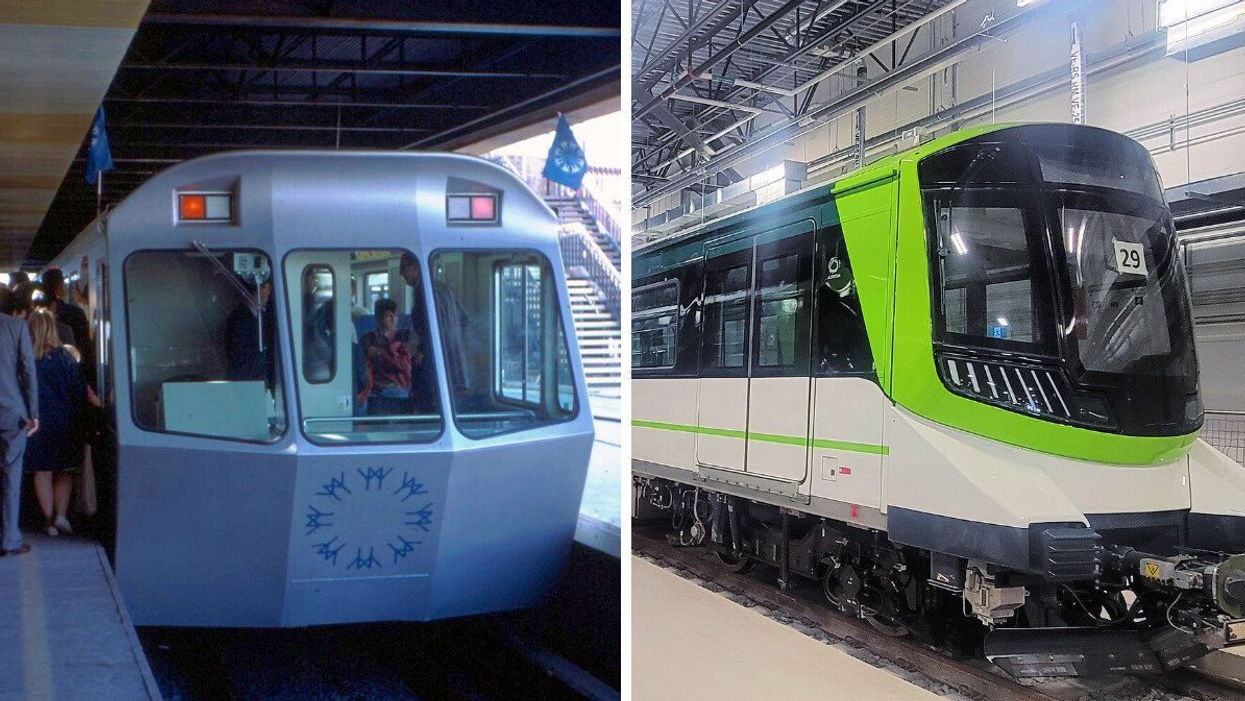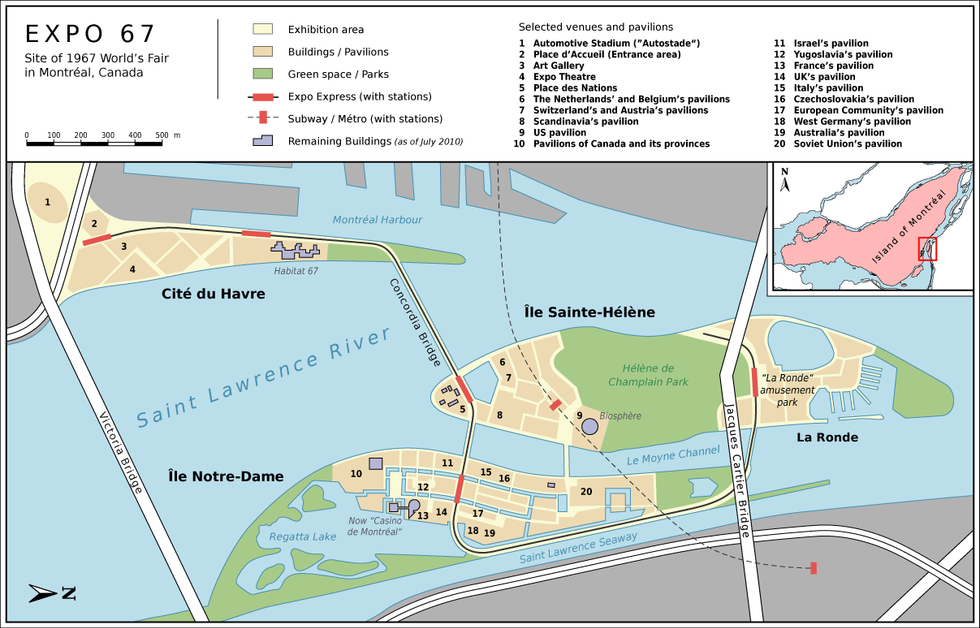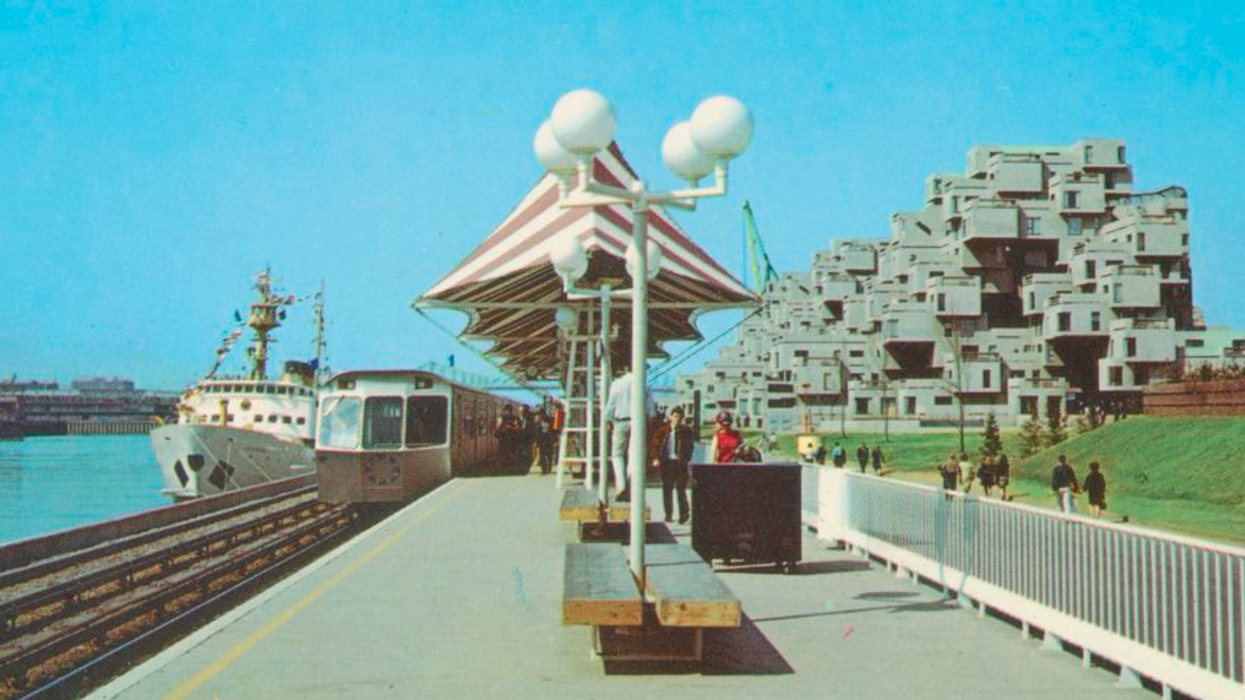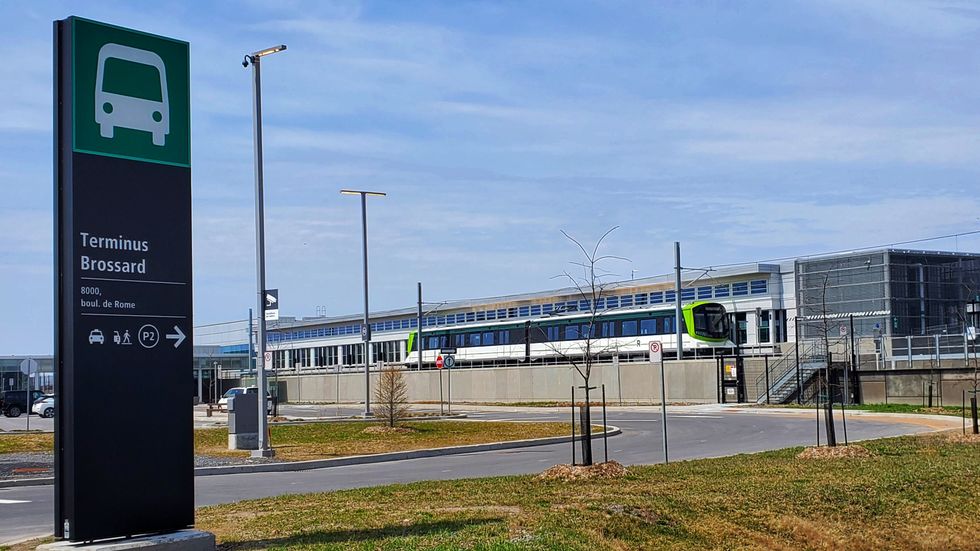Montreal's REM Is Channeling Expo 67 & Taking Riders Back To The Future With Driverless Trains
What's old is new again. 🚆

People board the Expo Express. Right: A REM car.
Your commute is about to get a futuristic facelift with a dash of déjà vu. As the city revs up for the launch of the Réseau Express Métropolitain (REM), you have to cast a glance back at Expo 67 and the visionary Expo Express.
Sixty years ago, a driverless train was so far-fetched, human 'conductors' were hired to play pretend and keep passengers calm. Now, as the REM prepares to whisk people around with no driver in sight, the question begs: have Montrealers outgrown the self-driving jitters, or are we just circling back to the future?
Rolling back in time
Montreal in 1967 was buzzing. Along with the hustle and bustle of Expo 67, a technological marvel was discreetly changing the face of transportation.
The Expo Express, North America's first automated rapid transit system, was zipping along an elevated track, transporting riders from the area near Farine Fives Roses to Île Notre-Dame, then Île Sainte-Hélène, and back.
The notion of a self-piloting train, even within the confines of the forward-thinking Expo, proved to be a formidable pill for the public to swallow.

For many, the thought of a driverless train was intimidating, so 'conductors' were hired to don the façade of control — posing, waving, and smiling — while the train drove itself. They provided a comforting illusion, making the ride more palatable for the hesitant.
Archival footage of the Expo Express’ debut is accompanied by space-age music showcasing how eerie and unnatural a self-driving train was considered at the time.
Footage of Montreal's Expo Express and how it was portrayed in 1967.Archives de Montreal | Youtube
Just as the Expo Express grappled with the complexities of transitioning from manual to automated controls, the REM, too, has encountered similar challenges.
A quote from the video summarizes the shared struggle: "It’s one thing to design and construct such an automated system. It’s another to check it out and make sure that everything works out perfectly." This same obstacle has led to multiple delays in launching the REM.

In the five years following Expo 67, the trains of Expo Express fell silent. The once futuristic transit system slipped into obscurity, leaving behind architectural echoes of its existence.
The line became a crumbling relic, while the main train station, a former hub for Expo visitors, was turned into the entrance to La Ronde (you can still see tracks beside the building). The promise of a futuristic above-ground transit was left unfulfilled — until now.
From novelty to norm
Fast forward half a century, and Montreal is hitting the refresh button on the light rail concept. The REM, with its state-of-the-art engineering and 60s-appropriate lime-green motif, marks a resurrection of that vision. But, unlike Expo Express, the new light rail system's driverless feature is openly advertised.
"At the time [of Expo], the technology was what we call a Grade of Automation 3 (GoA 3) system… The REM is a GoA 4, which is the latest grade in the world," REM spokesperson Marc-André Tremblay told MTL Blog.
For comparison, the REM operates at a higher grade of automation than the Montreal metro. The REM’s door closing and service interruptions are managed through fully automated protocols, ensuring higher efficiency and passenger safety.
"In the event of an equipment failure that could have an impact on safety, the system automatically switches to the fail-safe position. There is a control panel in each train, which allows the train to be operated manually, and we have drivers trained for that purpose," said Tremblay.
"Automated systems are the most reliable and secure in the world," he said, reducing the response time and variability that comes with human control and increasing the average speed of train operation.

No driver, no problem
The REM has implemented robust emergency protocols to ensure safety. In the rare event of a train becoming stuck between stations "all trains are capable of pulling or pushing another one to the next station, but this is the very last measure in place," said Denis Andlauer, Operations VP at CDPQ Infra, the company behind the REM.
A central "brain" located near Brossard station oversees the entire network, which is monitored 24/7. Similar dependable systems are operational in global cities like Paris and Shanghai. To thwart hacking attempts, multiple layers of protection are in place, including firewalls, authentication, encryption, antivirus software, and active threat monitoring.
With trains arriving every two and a half minutes during peak hours, and every five off-peak, waiting times will be minimal.
The REM will have 67 kilometres of track, two fewer than the STM's underground network. The metro caps its trains at a top speed of 72 km/h, while the REM can reach speeds of up to 100 km/h, meaning the REM will be more efficient while covering similar distances, even if it does have fewer stations. Plus, trains are equipped with heated couplers that work even in the frostiest of Montreal’s winters.
Andlauer confirmed that security cameras on board will be recording, but are only monitored in the event of an emergency, so, if you're nervous, note the safety features when you board. There won’t be attendants posing as drivers on the REM!
'On track' for the future
The REM has deep roots that trace back to Montreal's historic Expo Express. In fact, the manufacturers of both systems share a lineage through acquisitions and company mergers.
The story begins with Hawker Siddley, the British manufacturer that constructed the Expo Express cars in the '60s near Thunder Bay, Ontario. Over time, the Canadian subsidiary was absorbed by Bombardier Transportation
Further down the line, Bombardier Transportation was acquired by Alstom — the current manufacturer of the REM train cars. It's akin to your family tree tracing back to a locomotive pioneer.
The journey of the trains from their birthplace in Thunder Bay, Ontario, to Montreal offers an unexpected full circle. It seems, in the world of automated trains, the apple doesn't fall far from the train.
The first video in a Montreal REM series detailing the trials and tribulations of the getting the project off the ground.Paige Saunders | YouTube
This illustrious past doesn't overshadow the REM's futuristic shine, however. As Montreal YouTuber Paige Saunders, known for breaking down the complexities of the REM project in a recent video series, enthusiastically stated, "I'm looking forward to seeing people who never thought of taking public transit before, like on the West Island, taking the REM to downtown and watching a movie and going back home. It's going to be great."
"All the stations are going to allow us to build a lot more transit-oriented housing around them. We're definitely dealing with a chronic housing shortage now in Montreal, and that's just going to make it so much easier to find spots," he added.
The REM represents a significant boost for Montreal. It ensures rapid transit to areas typically accessible only by car, raises the bar in automation, and promises reliable service.
So, are we merely circling back to the future with the REM? Perhaps, but if the future brings swifter, cleaner, and more efficient transit, then it's a loop worth revisiting.
- Here's A First Look At Brossard's New REM Station (PHOTOS) ›
- What Montreal's Iconic Habitat 67 Was Supposed To Look Like (PHOTOS) ›
- Montreal's REM Is Almost Ready To Launch & You Can Be The First To Ride The Train — Here's How - MTL Blog ›
- 15 Energizing Activities You Can Reach By The REM Just Minutes From Downtown Montreal - MTL Blog ›
- REM Montreal Cheat Sheet: Tickets, Schedules & Everything Else You Need To Know - MTL Blog ›
- REM Montreal Is Throwing A Launch Party Downtown With Free Ice Cream & Live Music - MTL Blog ›
- The Montreal REM Is An Urban Miracle: Here's What It's Going To Change - MTL Blog ›
- High-Speed Rail Could Cut Travel Between Montreal & Toronto To 3 Hours - MTL Blog ›
- Great Scott! Downtown Montreal Is Hosting A 'Back To The Future' Live Concert & Screening - MTL Blog ›
- High-frequency rail from Montreal to Toronto will shape future cities — Here's how ›

